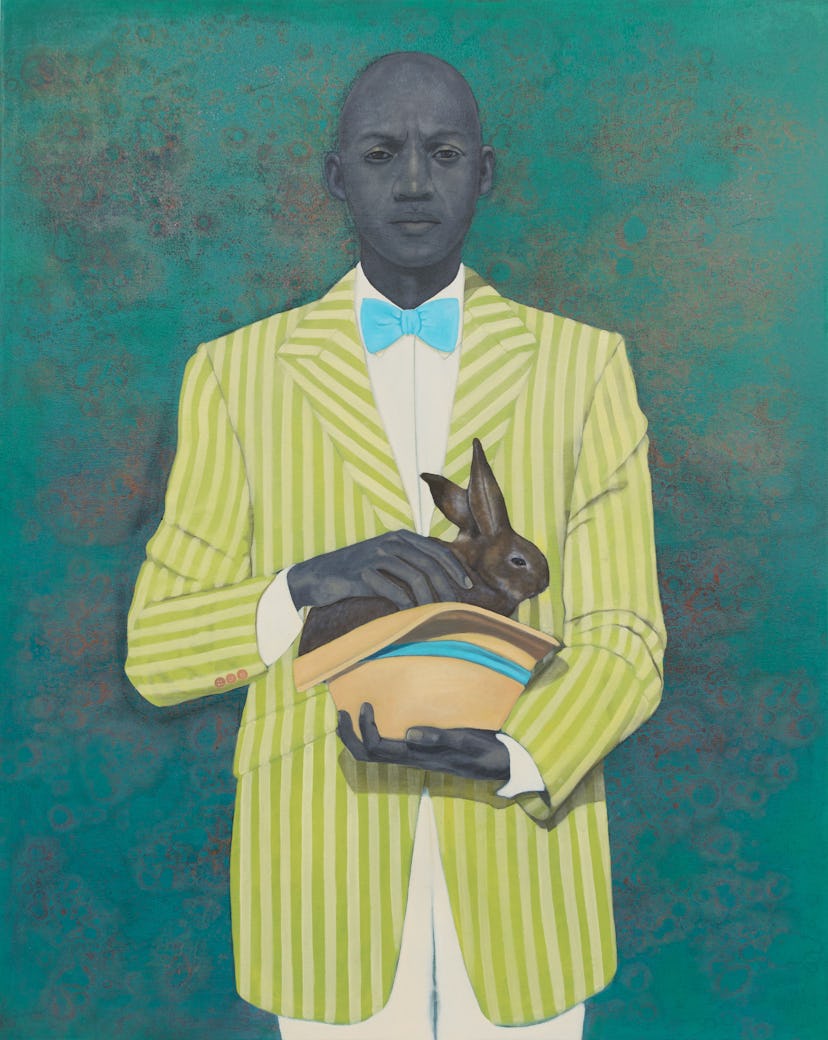Amy Sherald’s genius lies in her ability to get to the heart of things. The painter was famously selected in 2017 to create a portrait of former First Lady Michelle Obama—possibly Sherald’s highest-stakes subject to date (make no mistake, though, the Georgia-born artist was no rookie; she waited tables until she was 38 years old to fund her visual art career, and won the National Portrait Gallery’s Outwin Boochever Portrait Competition in 2016). In Obama she faced a public figure subject to unimaginable scrutiny, a woman who must appear pristine. Sherald’s painting of the FLOTUS, Michelle LaVaughn Robinson Obama, was hailed by art critics for its portrayal of poise and grace. But it also offered something more valuable than a veneer of perfection: the piece, done in Sherald’s signature grayscale, presented Michelle Obama as regal in her approachability. Spectators who caught a glimpse of the painting could see themselves in an historic figure.
Now, Sherald’s most heralded pieces—plus some new paintings—find a home at The Whitney Museum in New York City, which is mounting a landmark survey of the artist’s oeuvre titled Amy Sherald: American Sublime. On view through August 10, 2025, this marks Sherald’s debut solo exhibition at a New York museum, the second stop on a larger tour of the show which traveled from the San Francisco Museum of Modern Art earlier this year. (A corresponding book is also being published.)
Amy Sherald, Michelle LaVaughn Robinson Obama, 2017.
During a recent preview, The Whitney’s assistant curator, Rujeko Hockley, pointed to Hangman (2007), a work that considers the history of racialized violence in the United States. This piece in particular speaks to a central pillar of Sherald’s work: the investigation of Black subjects in the context of American realism. It is the earliest painting included in the presentation and hasn’t been seen since the year it was created; Hockley explained that presenting the works chronologically felt crucial to illustrating Sherald’s progression as a working artist for some 25 years, long before she became widely recognized for her portraits of Obama and, tragically, Breonna Taylor. “Amy has dedicated herself to Black Americans’ right to imagination,” Hockley said, noting the real power in painting figures that “inhabit fantasy and impossibility.” (A quintessential element of the artist’s practice and vocabulary is her use of grisaille, a method of painting in gray monochrome. By depicting all her subjects’ skin tones as grayish, Sherald lessens the focus on their races.)
Amy Sherald, Hangman, 2007.
Amy Sherald, Breonna Taylor, 2020.
American Sublime, a title culled from Elizabeth Alexander’s book of poetry by the same name, situates Sherald within the art historical tradition of American realism, a movement that played a crucial role in The Whitney’s founding almost a century ago, and is often associated with artists such as Edward Hopper. While the artist considers herself a successor of this tradition, her work points us toward its more expansive lineage, calling on artists like William H. Johnson, Archibald Motley, and Laura Wheeler Waring. Like Sherald, these (often underappreciated) artists prioritized painting figures that reflected themselves and their communities.
Amy Sherald, A Midsummer Afternoon Dream, 2020.
Sherald shared with W that she is “truly excited” for the show opening. “It feels like a full-circle moment,” she said, “to bring these paintings into a space that’s held so much of our country’s artistic history.”
This article was originally published on
